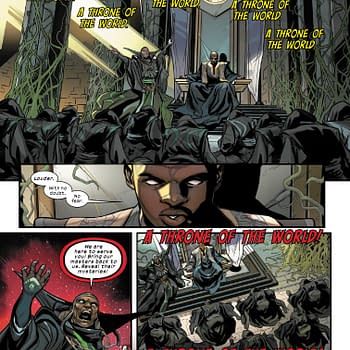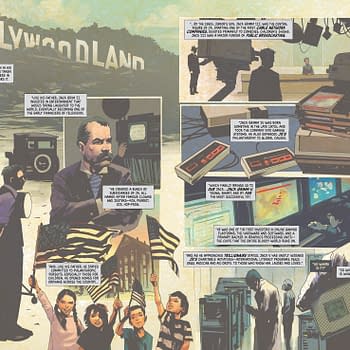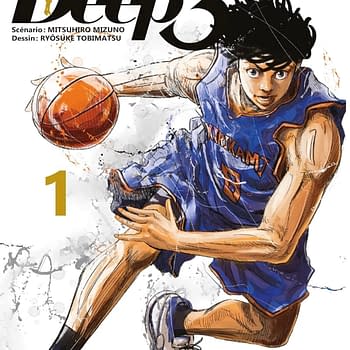Posted in: Comics, Recent Updates | Tagged: action lab, boom studios, Comics, dark horse, Ei8ht, entertainment, Plunder, Rafael Albuquerque, she-hulk, Silk
Thor's Comic Review Column – Plunder #1, Pirate Eye: Exiled From Exile #1, Ei8ht #1, She-Hulk #12, Silk #1
Reviewed this week:
Plunder #1
Pirate Eye: Exiled From Exile #1
EI8HT #1
She-Hulk #12
Silk #1
Plunder #1 ($3.99, Boom!)
By D.S. Randlett (@dsrandlett)
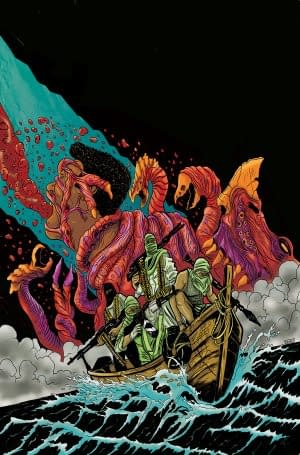
On that front, Plunder by Swifty Lang and Skuds McKinley certainly delivers, particularly on one particularly gross splash page near the end of the issue. If that page isn't a statement of intent for the rest of the series, I don't know what is. Leading up to that, Plunder is good enough, but fairly standard first issue fare. Still, Lang's script shows a grasp of the first act in horror that I haven't seen in a modern horror comic. Lang starts the issue as if it were any other day in the main character's life, it just happens to be a very unusual life.
Body horror is typically about change in one way or another, and the story here starts with a character in a state of flux. Formerly a smarter than average, ambitious, and law abiding youngster, Bahdoon has found it in himself to become a translator for a group of Somali pirates. It's also quickly apparent that he might not be cut out for the job. Not only is Bahdoon trigger-shy, but he's also a realist, and actually being with a group of men who he once worshipped as heroic adventurers has pushed him to a point of disillusionment. Bahdoon is a character who is at once standing in the open fields of a potential life, and trapped in a life that he might not want. While this is an issue all about setups and initiating mystery, Plunder sets the stage for a compelling character arc from the word go.
McKinley's art is good enough, but what he really excels at are the gross body horror elements. Flesh is thrown around and reknit into disgusting shapes here, and it's pretty obvious that McKinley took quite a bit of relish in rendering these scenes. Something about the way he draws certain faces inhibits their range of expression, though. The leader of the pirates is written as if he oozes menace, but it doesn't quite come through visually. Still, it's a nitpick on work that is, like the book as a whole, serviceable, and at times exceptional.
D.S. Randlett lives in the hills of Virginia and takes credit for the reviews that his emaciated twin brother writes while chained to the old radiator. He plays his guitar while biding his time for unsuspecting tourists and thinking about going to grad school.
Pirate Eye: Exiled From Exile #1 (Action Lab, $3.99, unless you want the variant cover. That will cost you another dollar.)
By Cat Taylor

I bring all this seemingly irrelevant information up for two reasons. One, to express my belief that the pirate comics being currently published are more likely due to the general hipster-cred that pirates have recently received rather than any ties to pirate comics envisioned in Watchmen. Therefore, what I thought would be cool when I was a youngling, has come to pass through different influences and with different results than what I envisioned at the time. Two, I wanted to go ahead and throw out the pre-emptive admittance that I went into this comic with an "I don't get it" attitude towards the modern pirate trend. Despite the fact that I, at one time, thought I would really like pirate comics, I now have to acknowledge that a lot of that belief was based on a pirate comic written by Moore, in the context of Watchmen, at a time when Watchmen was the most groundbreaking thing to ever hit the comic book medium. Therefore, I can't truly say that it was the pirate genre that I liked in those in-comic pirate comics. Regardless, I wanted to keep an open mind and try out a pirate comic to see what the genre might have to offer. However, after concluding the first issue of Pirate Eye: Exiled From Exile, my overall impression was that I did not read a pirate comic.
Josiah Grahn, writer of this issue, has crafted an entertaining story involving a few double-crosses, a law agent pursuing a criminal, shady dealings, and all the stuff that most people like in an action-adventure story. It's a good read but this plot could be at home in any number of crime procedural stories, westerns, space operas, or standard modern-day vigilante books. Sure, there were the superficial trappings of pirate costumes and a few ships, but there was nothing unique to the story that made this have to be a pirate comic. Perhaps that won't be a big deal to many, but it seems to me that when you market your story as being of a particular genre, you would want to set your first issue apart and give readers a reason to buy your "pirate" comic that they can't get in any of the hundreds of other books on the shelves. On the other hand, I've got to give Carl Yonder credit for his artwork. Although he seems to have trouble with the consistency of human faces that aren't shown in close-up, his work looks like the art from old comics of the 1950s. The end result feels like the appropriate style for pirate comics. Neither Grahn nor Yonder have a large body of well-known work to their name, but they have been working on the Pirate Eye universe for several years and have produced a comic that doesn't feel like the work of amateurs.
From an objective point of view with no expectations, this is actually a pretty good first issue for a comic book. It even has a story and conclusion of its own while simultaneously leaving a cliffhanger for the next issue in the larger story arc. My misgivings about recommending this title are based on the fact that I really didn't feel like there was anything special about the comic that would attract someone who was looking for high-seas swashbuckling and other random acts of piracy. The creators may sell a few copies of this first issue, but if those sales are based solely off the pirate angle I imagine that the drop off in sales from issue one to issue two will be much steeper than usual.
Cat Taylor has been reading comics since the 1970s. Some of his favorite writers are Alan Moore, Neil Gaiman, Peter Bagge, and Kurt Busiek. Prior to writing about comics, Taylor performed in punk rock bands and on the outlaw professional wrestling circuit. During that time he also wrote for music and pro wrestling fanzines. By the way, did you hear about the new pirate movie? It's rated AAARRRR! You can e-mail Taylor at cizattaylor@hotmail.com.
EI8HT
By Adam X. Smith

Rafael Albuquerque is an artist I've not yet had the pleasure of giving a proper day in court, mostly because the kind of stuff he's worked on has either flown under my radar or isn't my cup of tea. So when I discovered he was working on a new five-part series for Dark Horse Comics called EI8HT, with Supergirl writer Mike Johnson co-scripting and a plot that seems to fuse elements of post-apocalyptic fiction like Planet of the Apes (sans Apes, for the moment at least) with the likes of Memento and Looper, I found myself unable to resist checking it out. And, like I said, it was free, and I'm broke. Necessity is the mother of invention, after all.
What I didn't realise until I started researching this series is that it's actually a ground-up remake of a Brazilian webcomic Albuquerque made a few years ago called Tune 8, and whilst there appear to be certain panels that are lifted directly from the previous series, the characters have been completely redone and with Johnson providing a more nuanced script than a straight-up translation would necessarily allow for.
Set in an ambiguously post-apocalyptic time and place called The Meld, an amnesiac time-traveller called Joshua finds himself at the mercy of both the indigenous peoples of this brave new world and the fragments of his own memory slowly coming back into focus. Additionally he has a communicator that allows the architects of his mysterious mission (and possibly others too) to communicate with him across reaches of time (the title of the series comes from the frequency he is instructed to set the device to upon his arrival). Also, the man Joshua is instructed to seek out and kill and who is, based on what is immediately discernible, appears to be the series' nemesis, is an Aryan-looking, velociraptor-riding assassin who is acting as the tip of the spear for an unnamed tyrant. Yes, you did read that right – this comic contains time-travelling dinosaurs and Nazis; it could only be more awesome if it had tits that shoot shurikens and lightning.
Whilst the book's opening gambit of obfuscating the book's reality and making it unclear how what is happening relates to the past, present or future – even with convenient colour coding of each time period, it's still a lot to swallow all at once – it's more than made up for by the stark but inventive use of colour, line and negative space that Albuquerque uses to render the Meld and the pre-apocalyptic past Joshua hails from. And whilst I'm not sure that this series needed to be a complete page-one remake of the previous webcomic, the tweaks and changes evident in some of the comparable pages and panels seems to justify its existence as a sort of canonical reimagining or recreation of the original story by its creator.
I don't know if EI8HT is superior to Tune 8 overall, but as a piece in and of itself, it tided me over for a week and I'm interested enough in the story to revisit it again, and you could do a damn sight worse in this day and age.
Oh and one other thing before I go…
Whilst I didn't really have much interest in the rest of the stories in it, issue #200 of Dark Horse Presents has an excellent short story called "Masks", written by Gillian Flynn with art by Dave Gibbons, that ponders the ramifications of an angry mother's desire to protect her son from bullying by forming a group of masked vigilante women. Whilst it feels slightly old-fashioned in its style of writing and structure in a sort of reconstructed girl's comics of the 50s and 60s sort of way (and given Flynn's professed love of comics, I can only assume that's a deliberate stylistic choice), it's a pleasantly surprising bit of work from one of the greatest artists of modern comics and a writer whose star is continuing to rise and whose ability to span different media is showing that she isn't a one trick pony.
Well, that's it from me for this week – hopefully next time I'll be able to review something that costs real money. Peace out, my glib-globs. Wubbalubbadubdub!
Adam X. Smith is a traveller of both time and space, to see what he has seen.
She-Hulk #12 (Marvel, $3.99) and Silk #1 (Marvel, $3.99)
By Jeb D.
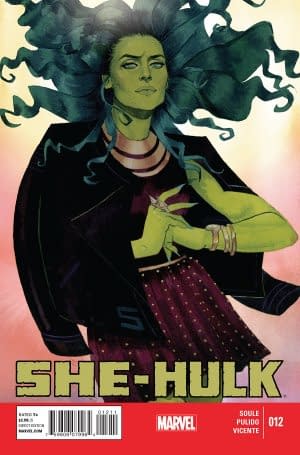
Charles Soule's take on She-Hulk draws to a close with a somewhat rushed final issue, and a bittersweet farewell page from Soule and editor Jeanine Schaefer. I'm not wholly on board with the slight melancholy, though: I've long believed that tightening up the run in any sequential medium can allow writers to be more selective, keeping the good stuff and reducing the need for filler (one reason, for example, that Marvel's Agent Carter works so well is that it only needs enough sharp dialog and action scenes to fill out eight episodes, not 22 or so), and calling a halt to the current series at 12 issues feels right. Even at that tidier length, this She-Hulk series took a bit of a detour in the middle, with the abrupt decision to put off the Blue File mystery till the end of the run, and devoting issue #11 to an extended, if entertaining, brawl between She-Hulk and Titania, leaving #12 with some heavy lifting (and a slightly awkward retcon) to bring the story to its close. Soule gives us the usual bromides about having had enough time to tell the story he wanted to tell, but the issue-to-issue pacing of the series would have benefitted from tighter overall plotting. Fortunately, Soule's smart dialog (and legal background) generally made the individual issues a rewarding reading experience.
The other abrupt change that happened during the run was the fill-in issues from artist Ron Wimberly, which generated what we might politely refer to as "a bit of controversy." Regardless of whether you regarded Wimberly as a true original or a complete incompetent, there's not much question that he was the polar opposite of regular artist Javier Pulido, replacing Pulido's smooth, clean, infographic-inspired approach with an aggressive, ragged style that suggested urban graffiti. From what I can tell, both had supporters and detractors, but Soule's scripts generally kept things moving, and there are enough developments in this final issue to give the next creative team to take a flyer at the Jade Giantess a strong foundation.
For anyone who hasn't taken a look at the current She-Hulk series, I'd recommend… well, definitely taking a flip-through before purchasing the trade collection: it's possible that there are readers out there who wouldn't have strong opinions about the art of Pulido or Wimberly, but I wouldn't necessarily count on your being one of them.

The script, from TV writer Robbie Thompson (Revolution) is slightly more problematic. You might call this a teen-superhero… well, not so much an origin story as a "point of origin" story: Silk's already been introduced over in Spider-Verse, but Thompson has the responsibility of establishing her place in the day to day of the Marvel U. And given that her superhero identity is shared with Spider-Man, and she's mirroring his career with things like working for J. Jonah Jameson, and going up against the Black Cat, Thompson's got a challenge that's not made any easier by the fact that we're not even two years on from the debut of Ms. Marvel, probably the best-reviewed and most boundary-stretching new superhero introduction of the century (not to overlook Miles Morales, making Cindy the third superteen of color Marvel has brought us in recent years). He quickly establishes convincing characterization for her parents, gets some fun out of the way that Cindy's two decades of imposed isolation have left her stuck in the 90's (she taunts bad guys with Pokemon references), and with Lee driving the story, he delivers a very entertaining first issue—but at this point, it's not clear why Marvel's new Asian-American superhero has to be so closely based on such a familiar template.
Jeb D. is really going to miss "Agent Carter."












